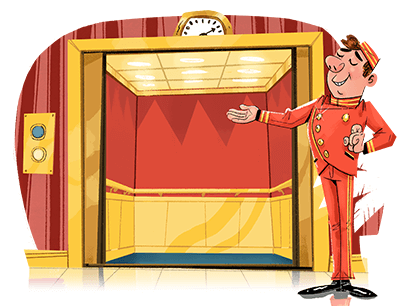
An effective elevator speech is a bantam biography you can use to intrigue a listener in the 20 to 30 seconds it takes to ride several floors on an elevator.
The elevator speech is a ready-made opportunity to demonstrate the concise speaking skills you’ve been perfecting in Toastmasters. During your career, you’ll be asked countless times, “What do you do?” The elevator speech is your polished and personalized answer.
Like any good speech, the elevator pitch is customized to the interests of the audience, whether it’s a one-on-one exchange or given to a group of people. Rather than touting degrees and titles, share details that will intrigue listeners and make them want to know more.
Take a basic paragraph about yourself and tailor it to the audience. Four common elevator elements are: your name, what you do, a snapshot of key strengths, and a micro example of how you’ve used your talents to solve a problem or deliver noteworthy results. Some people also include what they love about their job.
If you sense a spark among listeners, or someone has questions, you’ve made an initial impact, says Simon Bucknall, an executive speaking coach who presented “The Art of the Elevator Speech” at the Toastmasters 2020 International Convention. “Your listeners’ response will lead you,” adds Bucknall, who placed second in the 2017 Toastmasters World Championship of Public Speaking in Vancouver, British Columbia, Canada.
Some of his additional points: “People will rarely complain [about a short elevator speech] as long as you give enough information to move the conversation forward.” One of his favorites comes from motivational speaker W. Mitchell, describing how devastating accidents temporarily left him in the “prison” of a wheelchair. His mission to inspire others to rise above personal prisons led Mitchell to a fascinating elevator pitch: “I help people stage jail breaks.”
Stories can be a pivotal point in the elevator speech, Bucknall adds. “As anyone who’s been in Toastmasters knows, stories can bring a product, service, or idea to life.” The challenge is pruning a two-minute tale down to about 10 seconds. Crafting an elevator speech is “not an exact science,” Bucknall adds. “What resonates with one group or person may not with another. It’s not a fixed script, although in time, you start to figure out what messages people find relatable.”
Above all, a good elevator speech is delivered in a conversational and authentic tone. The speaker must demonstrate genuine enthusiasm. “If it starts to sound trite, your mindset isn’t right. You have to believe what you’re saying,” Bucknall adds.
Stephanie Darling is a former senior editor of and frequent contributor to the Toastmaster magazine.
Related Articles

Communication
7 Tips to Elevate Your Elevator Pitch

Funny You Should Say That
The Elevator Speech

Personal Growth



 Previous
Previous
 Your Toastmasters Elevator Speech
Your Toastmasters Elevator Speech
 Previous Article
Previous Article